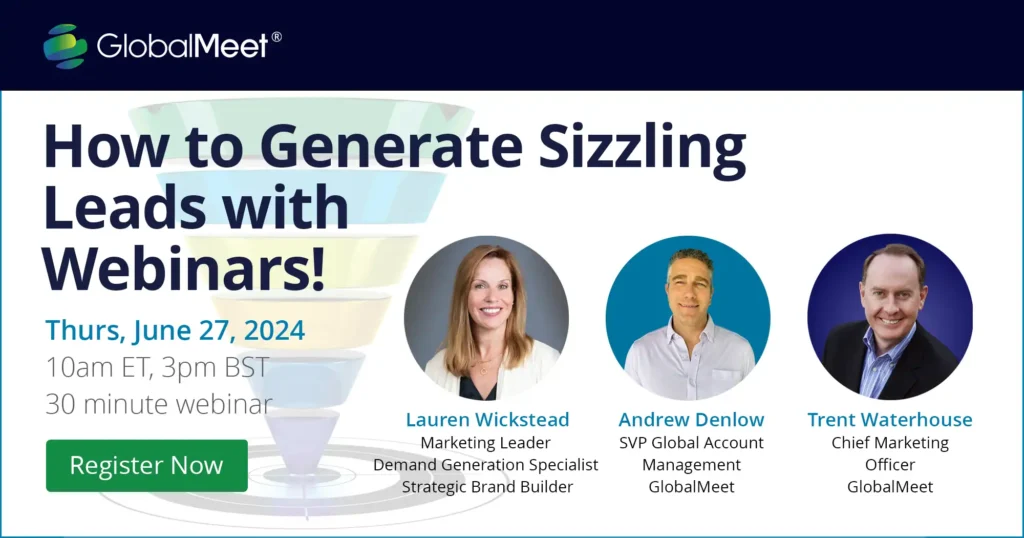
Virtual Event Marketing
- by GlobalMeet Blog Team
- ,
So you’ve decided to run a virtual event—great call. But it’s one thing to host a webcast; it’s quite another to have a buzzing audience that’s eager to engage. Let’s dive into the world of virtual event marketing, where the right strategies can turn your webcast, kickoff, or town hall into the talk of the… well, into the talk of the town.
Virtual events are exceptional tools for leading-edge businesses, but captivating performances, exciting brand presentations, and flawless virtual events are essentially useless if no one is there to soak it all in.
Virtual event marketing encompasses a range of tactics and methodologies designed to promote online events, webinars, and conferences, ensuring maximum participation and engagement. With platforms like GlobalMeet, organizing and marketing these virtual events becomes a streamlined, efficient process tailored to meet the diverse needs of today’s digital audience.
In this article, we’ll cover how to:
Understand your virtual event audience
Identify the optimal marketing strategies for your virtual event
Leverage a wide range of platforms and channels to promote your virtual event
Utilize GlobalMeet’s demand generation tools effectively
Understanding Your Virtual Event Target Audience
When it comes to identifying and understanding the ideal audience for virtual events, it’s essential to begin with a clear definition of your event’s objectives, ensuring they align with your broader business goals, such as lead generation or enhancing brand awareness. Delve into past event data to gather insights on attendee demographics, their interests, and feedback, which can be crucial in shaping your approach. Developing detailed audience personas is also key; consider aspects like job roles, industry sectors, and specific pain points that your event can address.
Further enrich your understanding through market research techniques like surveys, interviews, and competitor analysis, while also leveraging social media and web analytics to discern prevailing trends and traffic patterns. Engaging with online communities and industry groups can provide additional insights into potential attendee interests and expectations. This phase of audience analysis is foundational in creating a marketing strategy that resonates with your target demographic and drives event success.
- Data-Driven Insights: Use past data and market research to build a comprehensive understanding of your audience.
- Persona Development: Create specific audience personas for targeted marketing strategies.
- Feedback and Iteration: Continuously gather feedback and adjust your approach for maximum engagement.
- Internal Collaboration: Leverage insights from internal teams for a well-rounded understanding of customer needs.
By leveraging tools and insights offered by platforms like GlobalMeet, marketers can gain a comprehensive view of their audience, allowing for more personalized, impactful marketing strategies that truly speak to the needs and expectations of potential attendees. Our expertise enables you and your team to effectively bolster brand visibility, amplify lead generation, and accelerate the customer acquisition journey whether you have an audience of 50 or 100,000+.
Strategies for Effective Virtual Event Marketing
Crafting a successful marketing plan for your virtual event demands a blend of creativity, strategic thinking, and data-driven insights. This includes developing compelling and engaging content that captures the essence of your event, personalized messaging that resonates with your target demographic, and leveraging various digital marketing channels for optimal reach.
Utilizing GlobalMeet’s analytics and customization features, marketers can better understand attendee behavior and preferences, allowing them to refine their strategies for maximum impact. From social media campaigns to targeted email marketing, each tactic should be designed to build anticipation, encourage registrations, and ultimately drive attendance to your virtual events.
Below, we’ll cover the following strategies and channels:
- Social Media
- Email Marketing
- Content Creation
- Paid Advertising
- Partnerships
- Demand Generation with GlobalMeet
Leveraging Social Media for Promotion
Social media stands as a powerful tool for promoting your virtual event, providing a platform for wide-reaching promotion, audience engagement, and community building. Additionally, GlobalMeet’s integration capabilities make it easy to share updates and engage with your audience across these platforms, ensuring a cohesive and consistent promotional effort. By incorporating the following strategies, social media becomes an invaluable asset in promoting your virtual event, enhancing visibility, and engaging potential attendees effectively.
Diverse Platforms for Broader Reach
Use platforms like Facebook, LinkedIn, X, and Instagram to reach different segments of your target audience. Each platform offers unique ways to engage users.
Interactive Content and Engagement
Post interactive content like live sessions, event countdowns, and behind-the-scenes peeks. Use these to engage your audience and build excitement.
Hashtags and Consistency
Create a unique event hashtag to foster a branded experience and make it easy for attendees to find and share information about your event. Consistent posting helps maintain event visibility.
Paid Social Media Advertising
Once you identify the types of posts that resonate with your audience, consider boosting them through paid ads. This can expand your reach and attract more attendees.
Integration with GlobalMeet
Utilize GlobalMeet’s features to seamlessly integrate your social media efforts with your overall event marketing strategy. This ensures a unified approach and maximizes the impact of your social media campaigns.
Email Marketing for Virtual Events
Email marketing offers a direct and personalized way to communicate with your audience. It goes beyond mere invitations; it’s about creating a compelling narrative that resonates with your recipients. Effective email marketing for virtual events involves several key strategies, and by leveraging these tactics, you can transform every email into an opportunity to captivate your audience and drive event registrations.
Segmentation
Tailor your messages to different segments of your audience—such as customers, prospects, partners. This helps create relevant and engaging content for each group.
Personalization and Storytelling
Craft emails that tell a story about your event. Personalize these narratives to make each recipient feel uniquely addressed.
Frequent and Timely Communication
Start your email campaign about two weeks before the event and increase the frequency as the event approaches. This helps keep your event top-of-mind and builds anticipation.
Exclusive Offers and Reminders
Include sneak peeks, exclusive offers, or special guests in your emails to spark interest. Timely reminders can also help boost attendance.
Integration and Tracking
Utilize GlobalMeet’s CRM integration to track the effectiveness of your campaigns. Analyze open rates, click-through rates, and conversions to continuously refine your strategy.
Content Creation for Virtual Events
Content is the lifeblood of virtual event promotion. It’s what tells your story, showcases your value, and keeps your audience intrigued. Creating compelling content for virtual events involves a mix of creativity and strategy. This includes developing engaging landing pages, crafting informative and enticing blog posts, producing promotional videos, and utilizing interactive infographics. These content pieces should not only inform but also entertain and engage your audience, keeping them hooked and eager to learn more about the event.
With GlobalMeet, integrating this content into your virtual event becomes seamless, enhancing the overall attendee experience. From the initial announcement to the post-event follow-up, every piece of content should be aligned with your event’s goals, designed to inform, engage, and convert your audience into attendees.
SEO Strategies for Virtual Events
Search Engine Optimization (SEO) plays a pivotal role in enhancing the online visibility of virtual events. It’s a strategic process of optimizing your event website, landing pages, and content to rank higher in search engine results, thereby attracting more organic traffic.
Effective SEO for virtual events involves keyword research tailored to your target audience’s search habits, optimizing website content with these keywords, and ensuring your site is mobile-friendly and fast-loading. Don’t overlook the power of backlinks from reputable sites, as they significantly boost your site’s authority and search rankings.
Paid Advertising for Event Promotion
Paid advertising is a potent tool in the arsenal of virtual event advertising, offering the ability to target specific audiences and achieve immediate visibility. Platforms such as Google Ads (PPC) and social media advertising enable marketers to reach a broader and more diverse audience.
By crafting well-targeted ad campaigns, you can effectively drive traffic to your event registration pages. Utilize demographic, geographic, and behavioral data to tailor your ads to those most likely interested in your event. The key is to create compelling ad copy and visuals that resonate with your target audience. GlobalMeet’s analytics can assist in tracking the performance of these campaigns, allowing for real-time adjustments and optimization for maximum ROI.
Partnerships in Virtual Event Marketing
Strategic partnerships to promote your virtual event can significantly amplify your event’s reach and credibility.
Collaborating with influencers, industry experts, and other brands can open up avenues to new audiences and add a layer of authenticity and trust to your event. Influencers can leverage their followers to generate buzz around your event, while partnerships with industry leaders can lend expertise and thought leadership, enhancing the overall value of your event.
Consider co-hosting webinars or creating joint content to maximize the impact of these collaborations. GlobalMeet’s platform is designed to facilitate such partnerships, offering features that make collaboration easy and effective. From co-branded event pages to joint presentations, the possibilities are vast and can be pivotal in scaling your event’s success.
Virtual Event Marketing and Demand Generation with GlobalMeet
For brands looking to enhance their demand generation efforts, GlobalMeet offers a comprehensive solution. This platform is designed to simplify the process of engaging potential customers and increasing lead generation, regardless of the audience size, ranging from a small group to over 100,000 participants.
Key Features of GlobalMeet:
Branded Virtual Events: Create customized events that resonate with your brand identity, fostering meaningful connections and starting conversations that build lasting relationships.
Data-Driven Insights: Leverage powerful analytics to track attendee engagement, behavior, and demographics. This insight helps in understanding your audience better, leading to faster lead conversion and a robust sales pipeline.
- Flexible Management Options: Choose between a webcast subscription for the self-serve enthusiast or opt for a professionally managed event service for a hassle-free experience. GlobalMeet also offers comprehensive training to ensure you can utilize the platform to its full potential.
Seamless Integration: The platform integrates smoothly with most CRM systems, ensuring that your valuable data is readily accessible and usable.
Unlimited Event Hosting: With no limits on the number of self-serve events, GlobalMeet encourages users to maximize their outreach efforts, translating into unlimited opportunities for lead generation.
High-Quality Streaming: Enjoy flexible HD video streaming capabilities without any bandwidth interruptions, ensuring a professional and engaging presentation for your audience.
Measuring Success in Virtual Event Marketing
Measuring the success of your virtual event marketing strategies is crucial in understanding what resonates with your audience and what doesn’t. Key Performance Indicators (KPIs) such as registration numbers, attendee engagement levels, conversion rates, and post-event feedback play a pivotal role in this analysis. Utilize analytics tools to track these metrics, providing insights into attendee behavior and the effectiveness of your marketing channels.
This data-driven approach helps in fine-tuning future strategies, ensuring your marketing efforts are aligned with your event objectives. GlobalMeet provides robust analytics and reporting features, enabling you to measure the success of each aspect of your virtual event campaign, from initial outreach to post-event follow-up.
GlobalMeet not only aids in crafting an impactful first impression but also supports in nurturing these connections for a filled sales pipeline. It’s a tool designed to make your demand generation less demanding, yet more effective, offering the perfect blend of technology and ease of use for successful virtual event promotion.
Ready to elevate your virtual event marketing strategy? Explore GlobalMeet’s comprehensive solutions and discover how we can help you create unforgettable virtual experiences that resonate with your audience.
Request a demo today and take the first step towards redefining your virtual events.

How to Create a High-Performing Video Marketing Campaign
- by GlobalMeet Blog Team
- ,
Amidst tightening consumer budgets, economic volatility, and general uncertainty, marketers in the financial sector have to do more with less. Ad dollars must stretch farther, content needs to be re-purposed multiple times, and teams are embracing scrappier video production methods over expensive studio production. The average corporate marketing video, as part of a video marketing campaign, can cost anywhere from $2,000 to $7,000 to produce, and quite often, costs tend to go up into the tens of thousands. Twenty-two percent of marketers are creating a few videos a week, but with the promising results and success stories around video, that number will continue to increase.
Also, video is wildly successful across social media; organic social video gets 1,200% more shares than text and images alone, and 87% of marketers believe video generates a positive ROI. For marketing and social media teams looking to take their content strategy to the next level, here are a few tips on scaling content creation.
1. Empower Teams to Produce Content Independently
When 51% of marketers are still relying on internal teams to produce video content, it takes forever. Between multiple rounds of revisions, editing, and formal storyboarding, the process is dragged out and outdated. Encourage teams to spend a few hours a week brainstorming content ideas and then quickly putting those ideas into action through effective corporate video marketing strategies. Whether it’s educational content like “3 Ways to Save for Retirement” or informative like a market update, get teams empowered to be their own writer, producer, and editor for effective corporate video marketing.
2. Host Webcasts
Long-form videos like webcasts can keep customers and strategic partners highly engaged when done right. Whether on-demand or live, webcast platforms offer tons of different ways to engage your audience before, during, and after the event. Start the branded experience with on-brand content portals from GlobalMeet and create interactive polls and surveys for engagement during the webcast. Wrap up your successful webcast by integrating GlobalMeet with your go-to marketing, sales, CRM, and email automation platforms to provide critical attendee information to your other teams.
3. Test Live, Simulated Live, and Pre-Recorded Video
When you’re starting a new video strategy, you might not be sure exactly what resonates with your audience. Do they enjoy a long-form webcast at a specific time? Are they more willing to engage with financial advisor updates when they’re on demand? Experiment with different formats and styles to see what content dissemination strategy works best for you.
4. Streamline Your Workflow
From idea creation to editing to sharing across social media or your website, simplify all aspects of your video creation workflow. Obtain buy-in from leadership so your marketing team doesn’t need to run every single revision across the executive team. Employees will feel confident in being authentic, and production times can decrease. Minimize the number of technology apps used to create a single video.
Video Creation Across the Financial Services Sector
Video adoption has transformed multiple industries, and the financial sector is no exception. As marketers are forced to do more with less, reducing costs, decreasing product times, and accelerating content schedules are critical in maintaining a high-performing video content calendar. Contact our sales team to learn more about how financial services teams are adopting and scaling impactful video marketing campaigns.

Building Brand Awareness for Banks
- by GlobalMeet Blog Team
- ,
Banks in the U.S. have more competition than ever before. In addition to the bigger banks, local credit unions with a nationwide reach thanks to online banking, small traditional banks, and nearly 70 neobanks serve U.S. customers.
For industry-leading financial institutions, brand awareness for banks is often a non-issue, given their established recognition. But smaller brick-and-mortar banks, as well as start-up neobanks, struggle in a crowded marketplace. You can offer the highest interest rates, have the best banking app, and provide tons of benefits to members. But if they don’t know your bank exists, they can’t create an account with you.
Building a strong brand is critical to helping consumers find you online, feel secure enough to create an account, and, finally, develop loyalty toward your brand. Ultimately, the right online marketing campaigns and outreach efforts, along with great financial products and stellar customer service, can turn customers into brand advocates.
Why You Need Brand Advocates
Consumers may be leery of online banking, neobanks, and even smaller traditional banks following the collapse of Silicon Valley Bank and Signature Bank in March 2023. Yet, if people see their friends banking with a specific financial institution, they are more likely to trust it. One Nielsen study discovered that 88% of consumers said they trust recommendations from people they know above all other forms of marketing.
From the largest banks to the newest neobanks, many financial institutions have generous referral programs. Affiliate programs and referrer codes can help your business grow. But to leverage them, you must first build trust, loyalty, and brand awareness.
What’s the best way to build brand awareness for banks? Outreach campaigns that deliver value to your key target audience. Many banks have a broad target audience interested in:
- High-yield savings products
- Saving for retirement
- Rewards credit cards
- Fee-free banking
Once you identify your target audience, you can use GlobalMeet to create content that will capture their attention and build trust.
How to Create Value with Webcasts
You can create webcasts to build trust with your current members, sharing information on how to leverage your products to build their retirement accounts or ramp up their emergency savings.
You can also create events for those who may not be familiar with your bank. You don’t have to sell your products during these webcasts. Instead, seek to educate consumers on the importance of things like paying off debt, purchasing life insurance, or starting a retirement account.
Why Big Banks (and Small) Rely on GlobalMeet
GlobalMeet allows you to stream your events, conferences, and messages live to a global audience in real time or on-demand. As a cloud-based SaaS web solution, GlobalMeet is secure, scalable, and easy to use. That’s especially important when it comes to sharing information about financial services. Half of the largest banks in the U.S. trust GlobalMeet, so you can imagine what it might do for your brand.
Consumers have more choices in banking than ever before. But they need guidance to find the financial products and a bank they can trust. Use GlobalMeet to build brand awareness and trust.
Connect with us and create virtual and hybrid events that resonate with your audience.

7 Webcast Marketing Strategies
- by GlobalMeet Blog Team
- ,
Ready to get the word out about your next press conference, investors meeting, or an informative event for lead generation? It’s a noisy online world, and virtual events quickly get lost in the shuffle without a solid webcast marketing strategy.
From spreading the word through email marketing and public relations outreach to ensuring proper follow-up nurture with attendees, webcast marketing is most effective when you implement a variety of strategies across the entire journey. Leverage some of the below marketing webcasts tactics along with real-world promotions for the best results.
Also, don’t forget to closely track conversion rates, open rates, impressions, sales, and more along the various marketing channels. This will help evaluate the success of your marketing campaigns in driving awareness and, ultimately, generating more revenue.
1. Marketing Webcasts: Warm Email Marketing
While some consider email marketing “old school,” it’s still one of the most direct ways to reach consumers. While 99% of people open their emails every day, the average person also receives an average of 121 emails per day. Your email marketing strategy must be sophisticated and personalized, which helps you avoid the dreaded “delete button.”
Segment your list into specific audiences (think customers, prospects, partners, and more) to generate engaging content specifically suited to their needs. Kick off your email marketing roughly two weeks before the webcast and increase the email frequency as the day and time get closer.
2. Social Media Advertising (Paid and Organic)
Utilizing hashtags, emojis, posting consistently, and leveraging the power of the algorithm on top social networks is another effective strategy for getting your webcasts in front of the right audience. Use a specific hashtag to create a branded experience around your event and help potential attendees find more information. Also, don’t forget to constantly include a link to the registration page.
Once you’ve determined the types of posts and graphics that perform best, consider putting some ad spend behind that winning content. Social media ads are often more effective than other forms of advertising, and 72% of marketers regularly use paid ads.
3. Display Ads
Display ads are excellent ways to drive top-of-funnel awareness. When consumers constantly see your webcast advertised on third-party websites, on Google, or in other apps, they’re reminded to sign up for your event. The “Marketing Rule of 7” states that people need to hear about something at least seven times before they consider taking action, and display ads are an excellent way to increase the frequency of your drumbeat.
4. Content Marketing
With 70% of consumers preferring content marketing to traditional marketing, its vital to utilize this element in getting the word out about your webcast. Content marketing can range from long-form to short-form content or even simple repurposing of social or email content. Blog posts drive traffic to your website, and with the right keywords, your content marketing efforts can drive you to the top of Google search results. Over 25% of people click on the first Google search result, so making sure your events rank highly is important.
5. Partnership Marketing
Are you having well-known thought leaders speak at your event? Tap into their powerful network to broaden your reach and bring their audience into your webcast. Hand them a speaker’s media kit with graphics, digital flyers, pre-written social content, and other assets to make it easy for them to share.
6. Public Relations
Public relations can be as simple or complex as time and budget allow; craft a newsworthy press release and send it out on the wire for some extra visibility. You can also reach out to reporters and journalists who cover webcasts and other virtual events in your industry and offer them a compelling statistic or insight to write about.
7. Follow-up Marketing
Once the event is over, you still want to engage with these attendees. Make sure you gather the appropriate permissions to continue follow-up on other events and future webcasts. The marketing consent tracking tool in GlobalMeet helps you share privacy policies and terms of service and allows attendees to opt-in to hear from you in the future.
Market Your Webcast with GlobalMeet
Whether you’re reaching 50 people or 100,000+ attendees, GlobalMeet Webcast is here to power your successful virtual events strategy. With custom branding opportunities, attendee engagement tools, and robust analytics, GlobalMeet makes virtual events a key pillar in your webcast marketing strategy.
Check our checklist for promoting your events and contact us for a demo today.
Checklist: Promoting Your Virtual Event

Promoting your event online can be more important than hosting the event itself. You can plan the best event experience in the world, but if you don’t take the time to promote it, no one will attend. To effectively market the event, you’ll need to create assets that allow you to market it successfully and drive attendees to your website to sign up.
Download our free event checklist to ensure you don’t miss a thing.
Please Fill out the form below to access this content.

